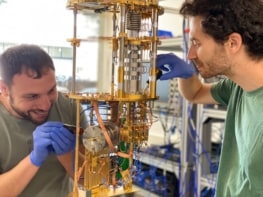
This tasty looking apple is an image of a new type of hologram developed in Japan that exploits tiny vibrations in metallic surface known as “surface plasmons”. The image holds its rich natural colours even as the viewer changes their position, unlike many existing holograms on the market. For this reason, the researchers believe that their innovation could lead to new display technologies such as smart-phone screens that can project lifelike 3D images.
A hologram is a recording of an optical interference pattern between light waves, and is generated in photosensitive materials using laser beams. Unlike 3D cinema projection, holograms appear to be 3D without the viewer needing to wear special polarizing glasses. Instead, holographic displays emit light in such a way that it produces many perspectives that allow the viewer to see the “object” from multiple angles.
Multicoloured holograms have been used for a range of applications such as the small multicolour icons used as security markers on credit cards. But these holograms tend to change colour with viewing angle due to information being lost when the holograms were produced. Now, Satoshi Kawata and his colleagues at Japan’s RIKEN research institute in Saitama have found a way around this issue.
Laser writing
Kawata’s team made their improved hologram by shining red, green and blue laser light onto a 150 nm-thick film of a light-sensitive material known as a photoresist, which was mounted onto a glass substrate. They then coated the photoresist with a 55 nm layer of silver followed by a 25 nm layer of glass.
To see the hologram, the researchers needed to illuminate the structure with white light to generate surface plasmons in the silver film. Plasmons are coherent electron oscillations that can be thought of as a quasiparticle that couples photons and electrons. By illuminating the hologram in three distinct directions, the researchers were able to generate plasmons corresponding to the red, green and blue features of the hologram.
Kawata told physicsworld.com that the tricky part was finding a way to balance the colours to represent natural colours, such as the subtle blend of reds and greens in their reconstructed apple. They managed this by carefully controlling the power of the laser when writing the holograms with multiple exposures for the three different colours.
Kawata is confident that the new technique could lead to applications, particularly for displays such as the smart phones of the future. “This hologram can be used by sales persons in a company to show their new products to their costumers,” he says.
‘A good scientific achievement’
Nasser Peyghambarian, a holography researcher at the University of Arizona, believes that this is “a good scientific achievement”. But Peyghambarian has a concern that the Japanese team will struggle to scale up the device up for practical applications.
Michael Bove Jr, another holography specialist working at Massachusetts Institute of Technology (MIT), points out that any new holography technique will face tough competition. “These fellows know a bit about physics but they clearly haven’t seen a lot of the holograms that are already on the market.”
“That said, this approach looks as if it could offer some advantages in light efficiency and view angle for mass-produced holograms, provided they can figure out how to mass produce their holograms cheaply.”
The findings are described in a new paper in Science 332 218.




